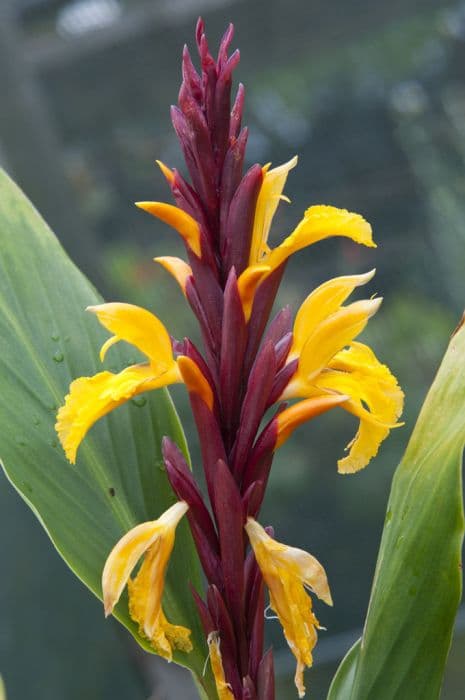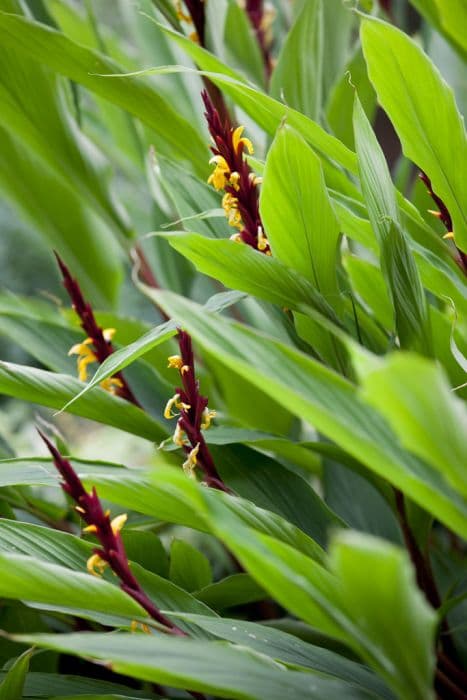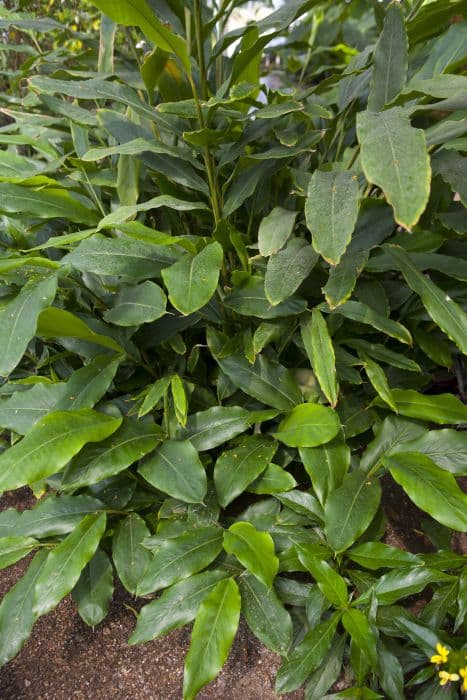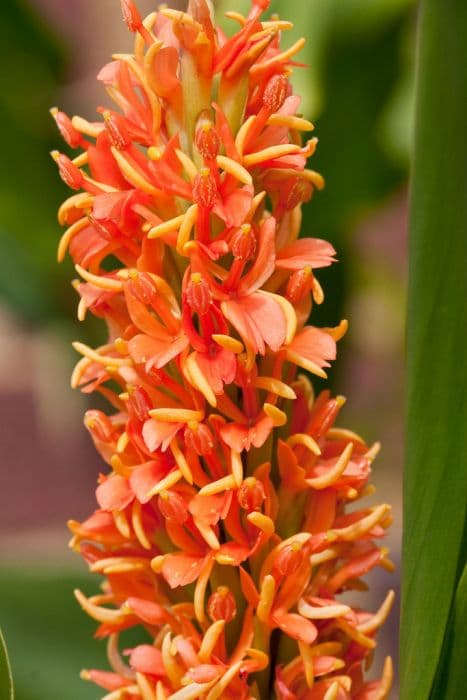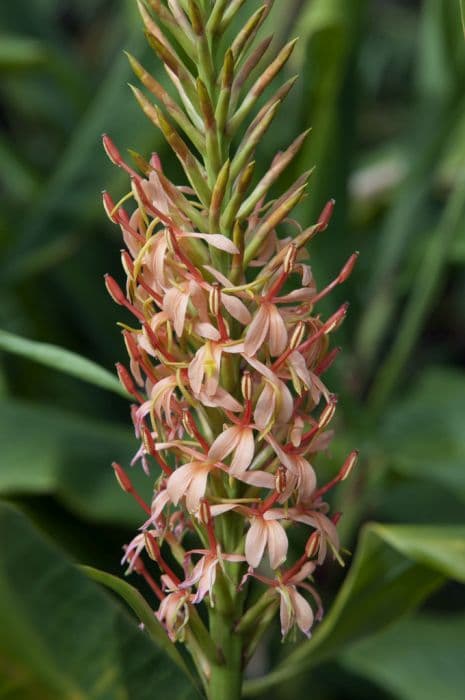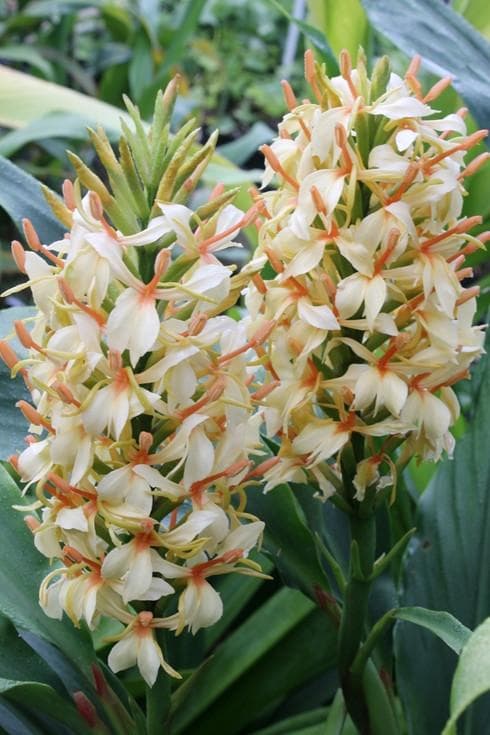Australasian Roscoea Roscoea australis

ABOUT
Roscoea australis, commonly known as the hardy ginger, is a perennial herb that is part of the ginger family. It is notable for its lush green foliage and striking flowers. The leaves are elongated, lance-shaped, and arranged in a spiral fashion around the stem, providing a dense and rich presence. The flowers of the hardy ginger are one of its most distinctive features, blossoming into vibrant shades that range from purple to lavender, with a rare appearance of whites or yellows. Each flower emerges from a bract, which is a small, leaf-like structure, and the blooms are typically large and orchid-like in their appearance, with a prominent lower lip and hooded upper petal that adds to their ornamental charm. The hardy ginger blooms in the warmer months, which adds a splash of color to the garden. In terms of growth habit, the hardy ginger tends to form a clumping mound, with the foliage and flowering stems emerging directly from the underground rhizomes. This gives the plant a neat and tidy appearance that is often appreciated in garden settings. The overall visual impression of Roscoea australis is one of an exotic and tropical plant, despite its ability to tolerate much cooler climates, which makes it a popular choice for adding an unusual and eye-catching flourish to temperate gardens.
About this plant
 Names
NamesFamily
Zingiberaceae
Synonyms
Southern Roscoea, Australis Ginger
Common names
Roscoea australis.
 Toxicity
ToxicityTo humans
Roscoea australis, commonly known as Himalayan Ginger, does not have a well-documented profile of toxicity to humans. There is no widely recognized evidence that suggests Himalayan Ginger is poisonous to humans. However, as with any plant, some individuals may experience allergic reactions or skin irritation when handling the plant, and it is advised to exercise caution and avoid ingesting any parts of the plant if its edibility is uncertain.
To pets
Himalayan Ginger is not known to be toxic to pets. There is limited information available on the effects of Roscoea australis on animals, and it does not appear on common lists of plants that are poisonous to pets. However, as with any plant not specifically meant for animal consumption, it is advisable to prevent pets from ingesting plant material, since individual animals might react differently, and ingesting non-food plants can sometimes cause gastrointestinal upset or other issues in pets.
 Characteristics
CharacteristicsLife cycle
Perennials
Foliage type
Deciduous
Color of leaves
Green
Flower color
Varies
Height
1-2 feet (30-60 cm)
Spread
1 foot (30 cm)
Plant type
Herb
Hardiness zones
6
Native area
Himalayas
Benefits
 General Benefits
General Benefits- Ornamental Value: Adds aesthetic appeal to gardens with its attractive flowers and foliage.
- Habitat Support: Provides nectar for pollinators such as bees and butterflies.
- Low Maintenance: Requires minimal care once established, making it suitable for busy gardeners.
- Drought Tolerance: Adapted to survive in periods of low water availability, reducing the need for frequent irrigation.
- Cold Hardy: Withstands cooler temperatures, beneficial for gardens in temperate climates.
- Soil Erosion Control: Can help prevent soil erosion when planted in groups due to its clumping growth habit.
- Shade Tolerance: Grows well in partially shaded areas where other plants might struggle.
- Long Blooming Season: Produces flowers over an extended period, offering visual interest for much of the growing season.
 Medical Properties
Medical PropertiesThis plant is not used for medical purposes.
 Air-purifying Qualities
Air-purifying QualitiesThis plant is not specifically known for air purifying qualities.
 Other Uses
Other Uses- Roscoea australis, also known as Himalayan ginger, has edible roots that can be cooked and eaten similarly to common ginger, although the taste might be different.
- The plant can serve as a natural dye for fabrics, with its roots and flowers potentially offering different hues.
- In landscaping, Himalayan ginger is used for its aesthetic value, with its lush green leaves and purple flowers adding vibrancy to garden settings.
- The flowers of Himalayan ginger can be used as a decorative element in culinary presentations, enhancing the visual appeal of dishes with their unique appearance.
- Enthusiasts of home crafts might use the dried seed pods of the plant in potpourri mixes due to their distinctive shape and texture.
- Budding photographers often use Himalayan ginger as a subject for botanical photography, capturing the intricate details and vibrant colors of its flowers.
- Practitioners of ikebana, the Japanese art of flower arrangement, may utilize Himalayan ginger for its exotic look and the curvature of its stems.
- The leaves of the plant can be used in compost as a green layer, contributing to the nutrient composition of the resulting compost.
- During educational activities, parts of Himalayan ginger can be utilized for botanical studies due to its characteristic features that represent the Zingiberaceae family.
- Himalayan ginger seedlings can be grown as curiosity-inducing plants in school gardens, fostering an interest in plant biology among students.
Interesting Facts
 Feng Shui
Feng ShuiThe Roscoea australis is not used in Feng Shui practice.
 Zodiac Sign Compitability
Zodiac Sign CompitabilityThe Roscoea australis is not used in astrology practice.
 Plant Symbolism
Plant Symbolism- Rarity: Since Roscoea australis, commonly known as Hardwar lily, is not as widely known or cultivated as other flowers, it can symbolize uniqueness or rarity in some contexts.
- Beauty in Seclusion: The Hardwar lily, which thrives in remote alpine regions, can represent the beauty that exists away from the crowdedness of everyday life. It may suggest an appreciation for solitude and the understated elegance that can be found in secluded places.
- Adaptation: As a species adapted to high altitudes, the Hardwar lily can symbolize the ability to thrive under challenging conditions or adaptability to changing environments.
- Resilience: Living in harsh mountainous climates, this plant can also stand for resilience or the capacity to endure difficult circumstances.
 Water
WaterHimalayan ginger should be watered once the top inch of soil begins to feel dry, typically once a week during active growth periods. Use room temperature water, and provide enough to moisten the soil thoroughly without leaving the plant standing in water. In cooler months, reduce watering frequency to every other week or less, depending on the plant's environment. A general guideline is to provide about one gallon of water per week, adjusting based on the plant size and environmental conditions. Always ensure adequate drainage to prevent root rot.
 Light
LightHimalayan ginger prefers bright, indirect sunlight but can tolerate partial shade. The best spot would be a north-facing or east-facing window where it receives gentle morning sunlight but is protected from the harsh midday sun. Avoid placing it in direct sunlight for long periods, as this can scorch the leaves.
 Temperature
TemperatureHimalayan ginger thrives at a temperature range between 60-75°F, with a minimum survival temperature around 50°F. Ideal temperature conditions lie within this range to promote healthy growth and flowering. Protect the plant from sudden temperature drops and drafty areas, which could stress it and lead to damage.
 Pruning
PruningPruning of Himalayan ginger is typically done to remove spent flowers or damaged leaves, enhancing the plant's appearance and health. Light pruning can be done as needed throughout the year, but any significant cutting back of the plant should occur in early spring before new growth starts. This helps to stimulate fresh growth and maintain an attractive shape.
 Cleaning
CleaningAs needed
 Soil
SoilFor Roscoea australis, commonly known as Himalayan ginger, the best soil mix is a well-draining, humus-rich medium with good moisture retention. A mix of two parts loam, one part peat or leaf mold, and one part sharp sand or perlite is ideal. The soil pH should be slightly acidic to neutral, ranging from 6.0 to 7.0.
 Repotting
RepottingHimalayan ginger should be repotted every two to three years to refresh the soil and accommodate root growth. The best time to repot is in the spring before the growing season begins.
 Humidity & Misting
Humidity & MistingHimalayan ginger thrives in moderate to high humidity conditions, ideally between 60% and 80%. If the air is too dry, the leaves may lose their vigor.
 Suitable locations
Suitable locationsIndoor
Place in bright, indirect light with moist soil.
Outdoor
Plant in partial shade with well-drained soil.
Hardiness zone
6-9 USDA
 Life cycle
Life cycleRoscoea australis, also known as hardy ginger, begins its life cycle when its seeds germinate in moist, well-drained soil in the spring. The seedlings soon develop into young plants with a rosette of green leaves, relying on favorable conditions of partial shade and cool temperatures to grow. Over time, the plant develops a rhizome, an underground stem from which new shoots and roots emerge, allowing the plant to spread and mature. During the summer, hardy ginger produces unique, orchid-like purple flowers that attract pollinators and subsequently produce capsules containing seeds. After flowering, the above-ground foliage of Roscoea australis dies back in the autumn as the plant enters a dormant period, with the rhizome surviving underground during the winter. In the following spring, the cycle recommences as new growth emerges from the rhizome, continuing the perennial life cycle of the plant.
 Propogation
PropogationPropogation time
Spring to Summer
Propogation: Roscoea purpurea, commonly referred to as Himalayan ginger, is often propagated through division, which is the most popular method. The best time to propagate this plant is in spring, after the last frost, when the plant is emerging from its dormant period. To propagate by division, carefully dig up the clump of the parent plant and gently separate the rhizomes, ensuring each division has at least one growth bud. Replant the divisions immediately into well-drained soil at the same depth they were originally growing and water them thoroughly. This vegetative method of propagation ensures new plants will be true to the parent plant and is preferred due to its simplicity and effectiveness.
